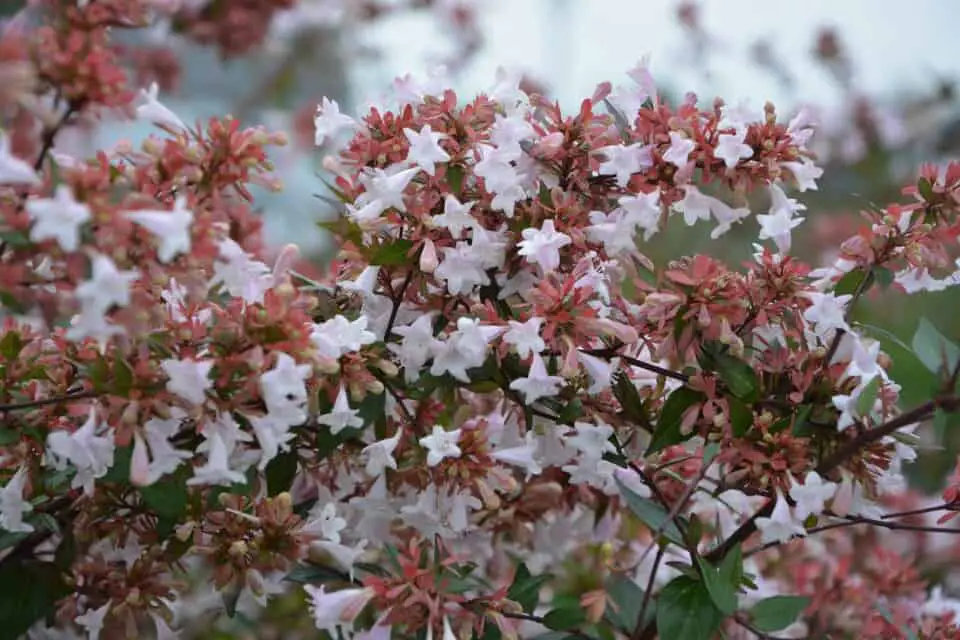Some links in the post are affiliate links and I get a commission from purchases made through some links found in the post.
Grown for its delightful foliage and the long blooming time, it is little wonder that Abelia ranks high up in popular plants. Once they are established, they are almost maintenance free.
Related to the Honeysuckle, you will find that there are about 30 species which are evergreen and deciduous, the most common being the Glossy Abelia.
The leaves are eye-catching in different colours ranging from gold to burgundy. The blooms are fragrant and long lasting.
Although it is not generally recommended that you grow Abelia indoors in a pot, there are ways to keep the plant healthy if you choose to do this.
In fact, the smaller varieties make excellent pot plants, and the range of colour makes them a great addition to any patio or garden.
Possibly one of the main points in the maintenance of Abelias is the lighting as it is this that contributes to the growth and blooming period.
While Abelia is not that fussy about soil conditions, it is very picky about the lighting conditions where it is placed.
The ideal light conditions for your Abelia are in full sun, either with a south or east facing spot and sheltered from the wind for more than six hours each day.
This is where sometimes it becomes confusing about where to set our Abelia for the best possible source of light.
We’ll look at how to give your Abelia the very best lighting you can.
Types of Abelia
Although there are more, these are the three most popular varieties of Abelia.
Glossy Abelia
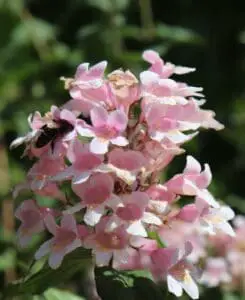 This variety is grown in many regions and can tolerate cold to warm places easily. The foliage is shiny – hence the name ‘glossy’ and the foliage in warm regions is lasting and bright green.
This variety is grown in many regions and can tolerate cold to warm places easily. The foliage is shiny – hence the name ‘glossy’ and the foliage in warm regions is lasting and bright green.
The glossy abelia is considered a tough plant. So much so that one of the horticulturists working on the Abelia breeding programme (yes there is one) at the University of Georgia, stated that at the university they called the Abelia the ‘gas station plant.’
This is because you could plant it next to a gas station, surrounded by asphalt, forget all about it and the plant would still survive. Not only this, but Abelia would thrive.
Indeed, the beautiful blooms will still be there long after other plants have succumbed to summer heat.
Kaleidoscope Abelia
This is a dwarf variety and very popular for its foliage which changes colour with the seasons. In the spring the foliage is yellow and then changes to a bright orange/red in the fall.
Along with the beautiful foliage the plant has small white flowers in the growing season.
Growing no more than two and a half feet in height this variety is great for pots and indoors.
Rose Creek Abelia
This variety is also popular for its unusual colour combinations. The glossy green leaves turn to bronze in the fall, while the flowers change from pink to white as the season changes.
Additionally, the branches of this variety are a deep red in colour.
This variety grows about 3 feet wide by 3 feet in height.
What Type of Light does my Abelia Need?
In the garden your Abelia will be happiest in full sun, although partial shade will also do.
However, if you want your plant to bloom more, then you need to focus on areas where the plant is in full sun rather than in dappled shade.
A general rule of thumb is that your Abelia needs more than 6 hours of direct sunlight every day.
If you cannot provide this because of the climate you live in, then you may want to consider using artificial light to keep your Abelia happy and blooming well.
Full sun
This means exactly what it reads. It is where your plant receives the maximum amount of sunlight in any given day.
With Abelias if the sun is extremely intense at midday, they will tolerate a dappled afternoon shade. However, they much prefer constant sun during the day.
Partial shade
This means that the plant receives less than four hours of direct sunlight per day, although more than one and a half hours.
Any less than this is classed as being a shade plant. Partial shade also means that the plant needs to be sheltered from the hot afternoon sunlight.
Artificial lights
If you plan to grow your Abelia indoors or if you are starting your plants from seeds you may think about using some form of artificial lighting.
Artificial lights come in several types:
Fluorescent lights
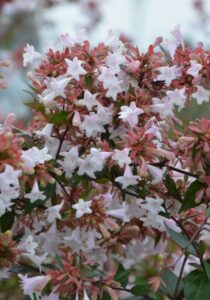 If you plan on using any artificial light for your plants then this is the easiest to get hold of and the most economical to use. You can buy fluorescent lights in tubes or bulbs. The bulbs will fit into regular socket fittings.
If you plan on using any artificial light for your plants then this is the easiest to get hold of and the most economical to use. You can buy fluorescent lights in tubes or bulbs. The bulbs will fit into regular socket fittings.
These lights are cool enough to place close to plants without damage.
Most of the generic bulbs are higher in blue wavelengths so look for those with a mixture of cool and warm or opt for full spectrum ones.
If you are ever in doubt about which ones to buy go for the cool white variety and keep them about a foot away from your plants.
Incandescent lighting
These give off a lot more heat so should be placed further from the plant. Because they are more on the red wavelength they are good for encouraging plants to bloom.
Incandescent lights can be used to supplement fluorescent lights. If you want to mix them up then use a ratio of one third incandescent and two thirds fluorescent.
LED lighting
These are also low heat and an energy efficient light source. Every bulb is different so you should look for a combination of reds and blues for your plants and both are needed for help them grow.
You can often buy horticultural LED grow lights which are designed to be used with plants so if possible, go for these.
Horticultural lighting
Generally, these come in tubes as fixtures. They have a full spectrum needed for helping plants to bloom. Additionally, if you plan on propagating your Abelia this is a good artificial light to start your seeds.
Halogen lighting
As a last resort these will work buy be aware that they give off a lot of heat and are far less energy efficient than other artificial lights.
You may also like: Abelia vs spirea
How Much Light Does an Abelia Need?
While your Abelia may thrive in any type of soil, it does need full sun to be at its best. Full sun is where the plant receives sunlight for more than six hours each day.
South or east facing positions are best in sheltered places.
What happens if your Abelia gets too little light?
If your Abelia gets too little light it will manifest itself in a leggy appearance and less blooms.
The plant will need to grow towards the sunlight or light source to do well and without enough light it will become straggly. You will also notice a depletion of blooms.
What happens if your Abelia gets too much light?
If we remember that Abelia loves the sun, we can assume that there is almost no situation where it gets too much sun.
However, what a full sun position in a hot country may do is to cause it to wilt a little. In extremely hot areas Abelia will do well in afternoon shade spots.
Too much direct sunlight in a hot climate may result in leaf burns. You may notice the top leaves turning yellow or even brown and developing a burnt look.
Brown and yellow leaves are also a sign of a plant which is deficient in nitrogen. However, the difference is that with leaf burn the leaves will not drop off as they would with a lack of nitrogen.
Can abelias grow in shade?
Abelia grow best in full sun and partial shade so if they are placed in a full shade spot, such as under a large leafy tree or in a spot where the sun never gets to, they will not be happy.
You certainly won’t get the lush green foliage and the beautiful blooms you will see in the right light conditions.
Where to place your Abelia to get the best light
Indoors
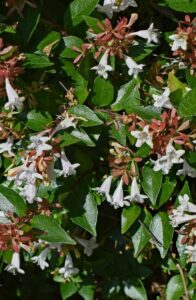
Yes, they can, and they will adapt to light other than the sunlight outside, provided it is consistent.
If you plan on growing your Abelia indoors then think about a windowsill, or at least very near to the window which faces the south.
Of course, the issue with planting Abelia in pots indoors will always be the winter months when there is simply not enough light for the plant. You may need to add artificial light then to keep your plant happy and blooming.
Outdoors
Avoid planting your Abelia under a very leafy tree, where the plant will be in shadow all day long. Rather opt for a sunny corner where it will be protected from strong winds but also receive at least 6 hours of direct sunlight per day.
If there is going to be any dappled light, then it should be in the afternoon rather than in the morning. This is because the morning sun will be cooler than the afternoon sun so less chance of burning the leaves.
Can Abelias grow in artificial light?
For your Abelia to successfully grow under artificial light it needs:
- Blue waves for the foliage
- Red waves for flowering
Plants have little use for green waves and just reflect them back. This is the reason why leaves appear green.
How to grow a Abelia using an artificial light
The light from a window will not be enough for the Abelia, particularly if you plan to start your plants from seeds. Seedlings that do not get enough light will become leggy and weak.
Spindly plants and seedlings are a classic sign of either too much nitrogen in the soil or not enough light. In this case it will be not enough light.
Position the bulb just a few inches above the seedlings and be aware that you will need to adjust the bulb as the seedlings grow.
The light needs to be turned on for at least 14 hours each day, preferably 18 hours a day.
It is a good idea to suspend the artificial light from the ceiling and you can rig this up using a chain system.
This will help you to keep the light at the correct height above the seedlings or your plant. It also means that your plant and the seedlings will grow upright rather than towards the light source at the side.
Artificial light ranges from inexpensive to quite pricey but it is worth remembering that this is often a one-time expense as they last far longer than regular light bulbs.
Once your Abelia seedling are established you should handle them much the same way as any other seedlings. Harden them off before you pop them into the garden.
Take your plants outside for a few hours at a time each day to acclimate them before the final transplant into a pot or the ground.
This way they will get used to the varying conditions outside, like wind and rain.
Final Thoughts
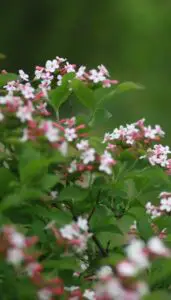 Abelia is not a fussy plant in that it has no issues with the soil you use around it. You can transplant it in either fall or spring but fall plantings will make regrowth easier.
Abelia is not a fussy plant in that it has no issues with the soil you use around it. You can transplant it in either fall or spring but fall plantings will make regrowth easier.
The one thing that your Abelia needs is full sunlight, every day. Place it in a sheltered spot where it can soak up the sun. If you must place it in a dappled area then opt for morning sun and afternoon dappling.
If you choose to grow our Abelia in a pot then plan on repotting it every 2-3 years.
So, we can see that Abelia’s are truly low maintenance plants, with the only real need being for plenty of sunlight.
It is no wonder that this plant is so popular in gardens and even in homes, and with a little bit of planning, there is no reason why your home or garden should not be home to one or even more of these delightful plants.

